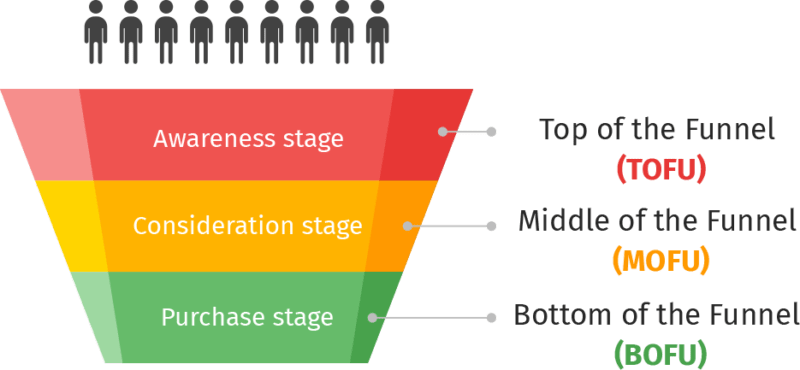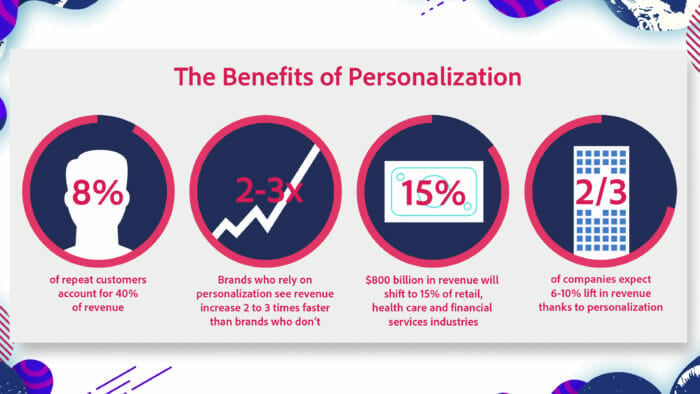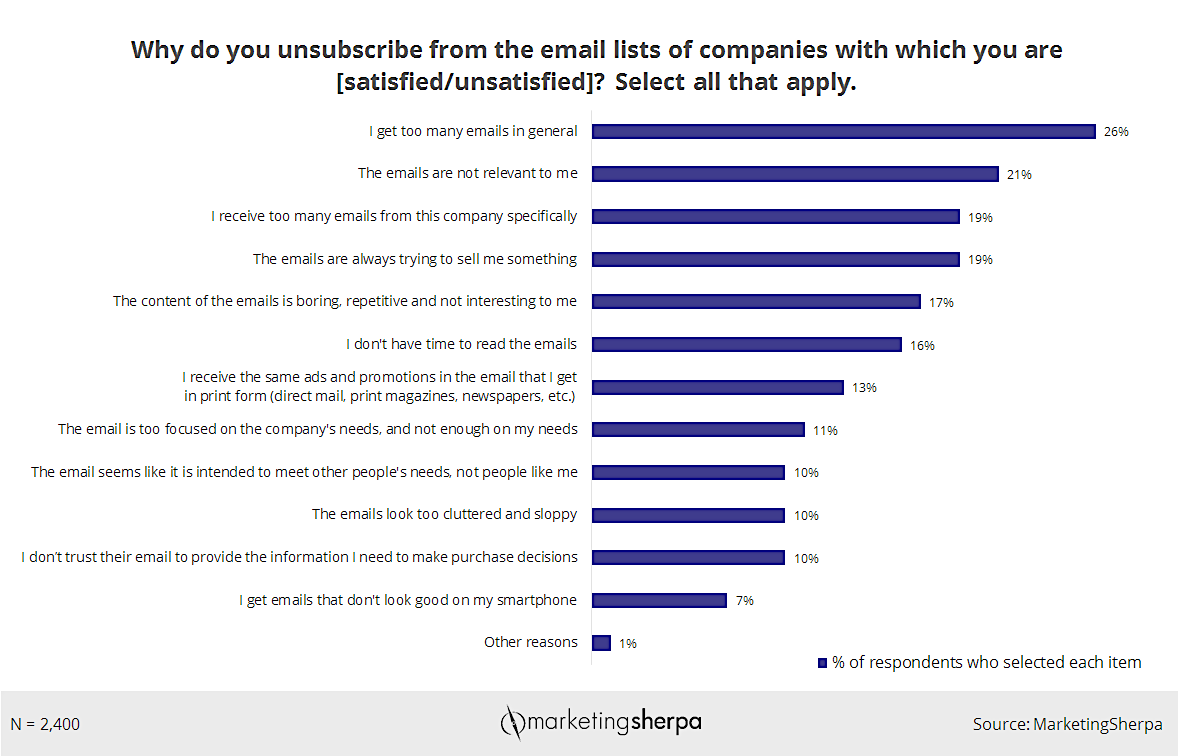A lead nurturing strategy is a powerful tool that helps to increase the effectiveness of marketing campaigns by leading the target audience to the buying stage. Providing relevant content at the right time is the basis for successful lead nurturing.
In this post, we’ll go through these 7 best practices that every marketer should make note of:
- Centralize Your Content According to a Sales Funnel
- Personalize What You Write
- Do Timely Follow-Ups
- Create Content that Resonates with Your Leads
- Provide Guides
- Use Marketing Automation
- Use a Call-to-Action (CTA)
1) Centralize Your Content According to a Sales Funnel
To understand the selling process, one needs to understand the various stages that each customer goes through. A sales funnel consists of three steps, or stages: awareness, consideration and purchase. Each one determines the processes with which you should be acquainted. Here’s an example of a sales funnel:

- Awareness (TOFU). When an individual enters your sphere of influence by means of filling out a form on your site, he or she becomes a lead with specific needs to fulfill or problems to solve. And first things first, you should start by defining their needs. This is done by looking into which products they might have viewed on your site, in order to gain insight into their awareness of your brand.
- Consideration (MOFU). At this step, your leads need to obtain more information about you, as it will determine if they need your products or services. The best thing a business can do at this step is to build trust with its leads by providing them with valuable information about the brand and its advantages.
- Purchase (BOFU). The bottom of the funnel is the customer’s purchasing point. However, this is not the end of the cycle. You should always consider keeping in touch with your customers to nurture their need to return to your brand. The purchasing step requires solid customer service that satisfies the customer’s needs and creates a positive experience. Building connections and establishing trust between your brand and your leads is an effective way to increase sales, and gain prospective clients and customers.
All these steps have different intentions which require different methods, and therefore different content.
One of the most essential tasks in a lead nurturing strategy is defining what content to create and which stage of the sales funnel it is meant for. Click To Tweet
Centralizing your content around each step of a lead’s journey is important in order to make your strategy effective. The best way to understand what information your leads need and when you should provide them with it comes from analyzing the data you’ve gathered from your leads. But your own experience can also help in this situation.
Just like how a dessert is best served at the end of a meal, the information you provide is best “served” at a specific point in time. For example, at the awareness stage, intense pressure can become a reason why your lead may never make a purchase. This situation might force them to ignore your emails instead. And this is not what your aim is.
Dive Deeper:
2) Personalize What You Write
Creating content that speaks directly to an individual is a way to build trust and make your lead feel like a person and not just a number on your list. That’s why it’s so essential to address your leads using their information, like name, location, job industry, etc.
Lead nurturing can be provided using different channels, such as:
- Emails (automatic emails, follow-up emails, announcements, news, and information campaigns)
- Social media (surveys, target messaging, entrainment content, and educational materials)
- Website content (landing pages, blogs, and strategic content)
- Retargeting ads (as reminders to your prospective customers)
- Events and webinars
Each of these channels has its specifics. However, emails tend to be the most effective, as they have a personal approach and can be sent as frequently as you want.

Personalization of your emails will drastically affect the effectiveness of your email campaign, as:
Using relevant information and personalizing your emails means:
- Addressing and greeting each person by name
- Emailing according to time zone, location, age, etc.
- Using relevant keywords
- Providing information that touches a person’s interests and needs
For example, if you announce that you are going to hold an event in the USA, it’s unlikely that anyone from Canada will show up, right? So, it’s important to break your lead list into segments and email them in accordance with the content of your campaigns.
3) Do Timely Follow-ups
Some businesses set up automatic email campaigns to send follow-up letters to their leads every few months. That’s a mistake, and many marketers would agree because it’s too spread out. However, what can be even worse is sending follow-up letters every day or even a few times a day. Yes, there are companies that don’t understand how intrusive this is:

What’s the best method for sending email reminders when following your leads to the last step of sales funnel? One common strategy states that you should send follow-up letters to your leads in a specific pattern, like on the: 1st day, 3rd day, 7th day, 14th day, and 28th day. And after all that, every month.
That is fair enough. However, many marketers state that this level of communication takes too much effort and time. As a lot of leads will never make a purchase, contacting the same lead this many times and getting no progress seems like a waste of time. Therefore, it’s better to send 3-5 emails within 10 days apart, and then experiment with different frequencies, depending on the number of responses.
A sales funnel places all your leads into the following categories:
- New leads (awareness)
- Cold leads (the ones who were reached but never moved forward or responded)
- Warm leads (the ones who are already interested in your brand – consideration)
- Hot leads (the ones who will make a purchase soon – purchase step)
It’s convenient to break apart your lead list and control the frequency of your emails according to the categories that each lead belongs to. The more your lead is ready to make a purchase, the more information you should provide to them. You can schedule and track your email openings with the help of different tools, like Boomerang and Yet Another Mail Merge.
Dive Deeper:
4) Create Content that Resonates with Your Leads
As mentioned earlier, personalization is a key to building trust between you and your potential customers.

You can create and adjust content to make it resonate with the individualities of your leads, by following these easy steps:
- Identify your leads and create buyer personas through the use of demographic information, like location, job, age, etc.
- Find the pain points of your leads – what demands and needs they have, what problems they need to solve.
- Adjust the length, tone and aim of your emails and place them into the same categories as your leads.
- Incorporate examples that may resonate with the everyday lives of your leads.
- Send behavioral emails – emails sent based upon the sites a person visits, and the links he or she follows, etc.
- Show how you are not a bot by adding your contact information, a complimentary close, etc.
- Share your personal experience and the “behind-the-scenes” of your brand.
The more your emails and site content are oriented towards your leads, the faster you can increase your sales rates. The best way to understand what information your audience needs is to find out more about their everyday lives and interests.
5) Provide Guides
Helping your leads move forward in their buyer’s journey takes time and patience. Intrusive pressure is what you really want to avoid. How can you lead them towards the purchasing phase naturally?
Informative and educational content is the best way to help your lead understand all the advantages of your brand and how those advantages might solve their problems and satisfy their needs. The guides should differ according to the stage of a sales funnel.
For the top of the funnel:
- E-books
- FAQs
- Short informative videos
- Blog articles
- Research reports
- Comparison charts
- Infographics
For the middle of the funnel:
- How-to articles
- Case studies
- Webinars
- White papers
For the bottom of the funnel:
- Consultation
- Assessments
- Demos
Educational content is a great motivational force for lead nurturing, as it sparks interest and catches a prospect’s attention, even if he or she is not really interested in your products or services in the beginning. Click To Tweet
The further your lead moves through a sales funnel, the more in-depth the content they need. This is the reason why you must understand the aims of every piece of content you create, along with the audience it is created for. You can always draw your prospect’s attention towards pages they might find helpful by including links in your email campaigns.
Dive Deeper:
6) Use Marketing Automation
Marketing automation software can ease your lead nurturing. In an ideal world, every message your lead receives would be personalized and come with high standards of support service. However, this is not always possible.
![]()
That’s why many organizations find marketing automation systems useful and profitable in lead generation and lead nurturing processes.
How Does Marketing Automation Work?
You can use automation software for targeted messages, which vary depending on the actions your leads take within the parameters you establish. For example, if your lead is interested in a certain product, automation software can send him or her emails regarding price changes, new stock arrivals, similar product launches, or even product reviews.
You can also send: welcome letters, thank-you letters, abandon cart letters, webinar announcements, or even set up a specific scenario you might need for your brand. It’s a great time saver for brands with too many leads to follow up with manually.
Marketing Automation Case Study
Tom Hag, the email marketing manager of EssayTigers, states that marketing automation helped his company to shorten its sales cycles by 22%. Before incorporating marketing automation into their customer support process, it took 4.35 weeks from the date of registration of new users to place their first orders. Now it only takes 3.39 weeks, which is a significant change in the sale’s dynamic. It also helped reduce support team costs by 29.5% by lightening the support team’s load.
7) Use a Call-To-Action (CTA)
Calls-to-action are incredibly important in effective lead nurturing campaigns. CTAs are a great way to catch a potential customer’s attention so you can show them that you might have something they are looking for, which could provide a solution for their current problem.
You can and should use a CTA in:
- Blog articles
- Emails
- Webinars
- FAQs
- Demos
- Sidebars
- Homepages
- Product review pages
- Social media (on your business’ page and in posts)
- Direct mail
- Almost everywhere else
Make your CTA stand out by personalizing it. Having difficulty coming up with a good call to action? Ask yourself these questions:
- How can I draw my audience’s attention?
- What is an effective call-to-action for my products or services?
- Who will see my CTA?
- What is the best location for my CTA?
- How can I make my CTAs clear and understandable?
The answers to these questions will help you to form a call-to-action, which you will have to test and change if it is not effective enough. Testing and analyzing is the best way to understand if your strategy is good enough for a successful lead nurturing campaign:

Dive Deeper:
Wrapping Up
Lead nurturing campaigns are quite effective when it comes to increasing sales. Not every lead will become a paying customer or client, but you can get a positive dynamic in your sales by using these simple and effective tips for creating content for your leads:
- Create personas and break apart your list according to a specific funnel position.
- Make sure to address each lead in accordance with a category.
- Follow up with your leads and provide them with the content they need.
- Be truthful and analyze the value of the information you provide.
- Follow your leads through every step of the sales funnel and provide high-quality support.
- Use marketing automation software to be able to keep up with your leads at all times.
- Use strong CTAs to bring attention to your brand and boost conversion rates.
Providing the right information at the right time is key to successfully converting your leads into sales.